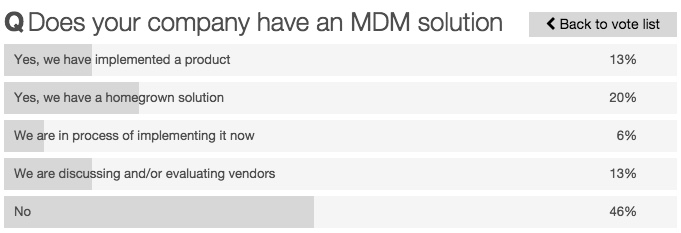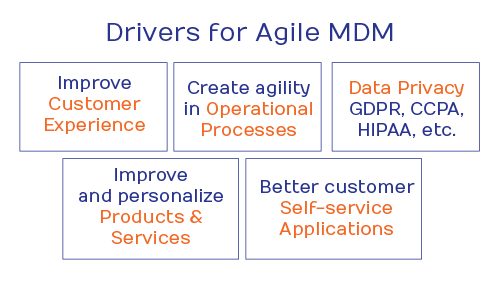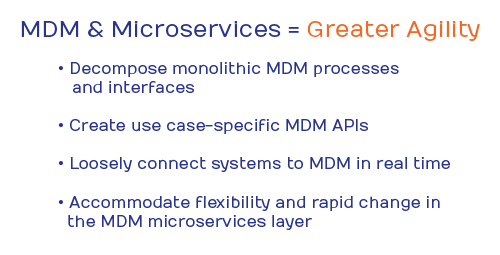As customer expectations escalate, competition increases, and regulatory pressures grow, organizations must demand greater agility from their master data management (MDM) systems: faster intake and outflow of data, more flexible support for business functions, faster response to changing business requirements, etc. Many organizations facing this new reality are questioning how they can achieve agile MDM without replacing their MDM systems entirely or implementing extensive customizations.
One approach we have found to be effective is creating a microservices layer that works in tandem with the MDM environment, which enables us to
- Decompose monolithic MDM processes and interfaces
- Create use case–specific MDM APIs
- Loosely connect systems to MDM in real-time
- Accommodate flexibility and rapid change in the MDM microservices layer
We recently explored how microservices can help you create an agile MDM in our webinar “Staying Ahead of the Curve: Microservice & MDM Strategies for Agile Architecture.” Below are some of the key takeaways and survey results.
Agile architectures need Agile data
At the heart of your enterprise architecture lies your data — data about your customers, your products, your processes, etc. To serve your organization as a strategic asset, your data needs to be
- well organized and well governed, and
- readily available to the people and applications that need it, when they need it.
By combining the benefits of MDM and a microservices architecture, you can build an agile architecture that lets you adapt to a continuously changing business environment and respond to evolving customer expectations.
Why MDM needs microservices
While MDM is a powerful asset in the drive towards greater agility, it only provides one piece of the puzzle. MDM lets you create a single source of truth to serve as a “back office” for your data processes, but does not always deliver that data to areas where it can support real-time business decisions and help you respond to customer needs. That’s where microservices come in.
A microservices architecture allows you to decompose MDM’s monolithic processes and interfaces to create use-case-specific applications. MDM takes care of the data quality and consistency, while microservices delivers it to where it’s needed, when it’s needed, helping you leverage data as a strategic asset and create a competitive advantage.
Survey results: Master data management
When we asked our webinar attendees whether their companies were using MDM solutions and/or microservices, the results showed that many are not yet using them or are in the early stages of planning:

Why Agile MDM?
Investing time and effort into achieving Agile MDM can deliver an array of benefits to your organization, including
- Improved customer experience: Provide customers with faster access to timely information.
- Operational efficiency: Agile MDM enables organizations to respond more efficiently to changing customer needs and expectations.
- Data privacy: Under traditional MDM, data is often replicated out to other data stores, which can lead to issues with data privacy and potential violations of GDPR, CCPA, and other regulations. In an agile MDM system, APIs can provide application developers with direct access to MDM system, which reduces the amount of data floating around the organization and lowers the risk of compliance issues.

Facing the Challenges
In the effort to make their MDM more agile, organizations can face several challenges, including the following:
- MDM is tightly governed and guarded.
- Integration is typically batch oriented.
- Most MDM systems are monolithic in design.
- Traditional MDM is data centric, not use-case centric.
- It has limited real-time connectivity for downstream applications.
- Most MDM systems contain data and process silos.
When we asked our webinar attendees to give their impressions of their current MDM systems, more than one-third confirmed that tight governance and difficulty in moving data in and out are key concerns:

How MDM and microservices result in greater agility
A microservice architecture helps organizations address MDM challenges by decomposing monolithic MDM processes and interfaces. Microservices let you create APIs that address specific use cases and loosely connect systems to MDM in real time. You will also be able to accommodate rapid change in the microservices layer without impacting the underlying MDM system.

Like what you see?

Executive Team member Kevin Moos is recognized for his experience with knowledge management systems. He has lent his expertise to several prestigious industry panels on enterprise content management and other topics.

